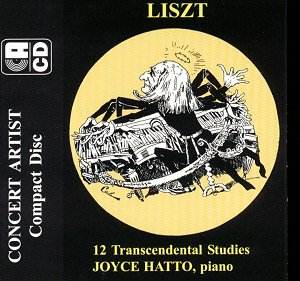Concert Artist now has two competing versions
of the Transcendental Etudes in its catalogue. They’ve only recently
released a recording made by Sergio Fiorentino in 1955 with patching
sessions made a decade or so later and never previously reissued.
Joyce Hatto recorded her set in 1990 and some sessions followed,
as with Fiorentino about ten years later. The edits, such as there
may have been, aren’t noticeable and the sound quality is natural
and without any glamorous cushion around it.
Hatto shares some of Fiorentino’s qualities as
a Lisztian of distinction. Her technique is formidable, her command
powerful, her feeling and sensitivity acute. She is not as inclined
to sculpt great dynamic gradients, as was the Italian, but her
musicianship here is certainly without empty bombast and mechanisms
for display. In the light of these competing versions and also
my own professed admiration for Fiorentino’s performance it seems
not inappropriate to contrast the two musicians’ approaches. In
the A minor Molto Vivace [No. 2] Fiorentino is more obviously
capricious and darting, his rubati more pronounced - his treble
rings out and he launches into the martellato episodes with drama.
Hatto doesn’t indulge the dynamic range quite so vividly though
her sense of architectural cohesion is splendid, her sense of
propriety and scale unflinching. In Paysage she is lyrical
and sensitive. She doesn’t summon up quite the sense of place
and of atmosphere that Fiorentino does; she is, and this can stand
as a definition of their respective accounts, more clear-eyed
than he. But she does bring out the ominous tied bass rather more
than Fiorentino. Mazeppa was a highlight of the Fiorentino
recording – virtuosity and pliancy in excellent balance and a
real sense of wit. True to her precepts Hatto’s virtuosity is
not in doubt but she doesn’t drive into the double note ascending
run with quite the command of Fiorentino.
I greatly admired her Feux Follets;
there’s an abundance of acute dynamics, evenness of runs,
scampering virtuoso pianism, effective pointing and an intense
awareness of rhythmic displacements. In Vision the two
views diverge. Hatto’s arpeggios and her conception are of great
nobility and heroism. Fiorentino is more concerned with tonal
shading and incipient tragedy. Hatto seems to me to sustain the
melody better through the span, Fiorentino starting rather more
slowly, the line being fractionally splintered as a consequence.
By contrast it’s Fiorentino who mines the heroic in Eroica
whilst Hatto exploits little agogics in the score to hint at the
wit within. Hatto is admirable in Wilde Jagd – she is subtle,
bold, building to the climaxes with inexorable logic and clarity,
using plenty of unsplintered chordal power. She draws out the
middle voices with great skill and imaginative clarity. Ricordanza
is wistful and romantic, with great subtlety of pedal. Hatto
possesses a sense of motion here that co-exists with rousing drama
and a truly glittering treble. The F minor Allegro agitato
molto sees Hatto’s precision and clarity paying dividends
– but Fiorentino is here galvanic and forceful, shaping the music
with irresistible drama and a tremendous sense of the cresting
rise and fall of the line, by the side of which Hatto can sometimes
sound just a mite literal. In Harmonies du soir she is
intimate and brings out the idyllic bell chimes well. If Fiorentino
is more lyrical, Hatto breathes in a fresh air landscape; healthy,
robust with a ringing grandeur to it. Chasse-neige, the
desolate conclusion to the set brings from Fiorentino a sometimes
cataclysmic terror limited only by the mid-1950s sound. Joyce
Hatto is not quite as free and impulsive, the chromatic flurries
are good but the fabric of the music could be even more dramatic,
the insistence more palpable. In the end she has to cede to Fiorentino
in matters of desolation and passionate conviction.
It has been a most worthwhile process charting
the perceptions of these two fine pianists in the Etudes. Fiorentino
seems to me more comprehensively and unsettlingly to explore their
breadth but Joyce Hatto lacks little in concentration and understanding.
Jonathan Woolf
MusicWeb
can offer the complete
Concert Artist catalogue
